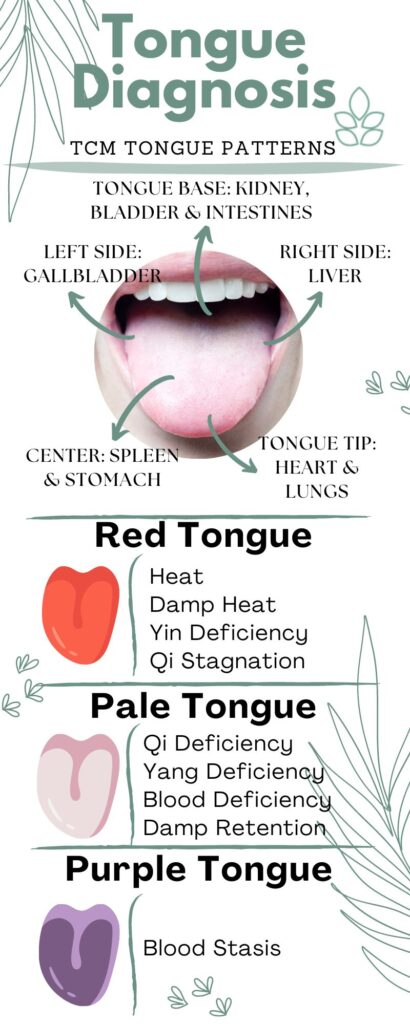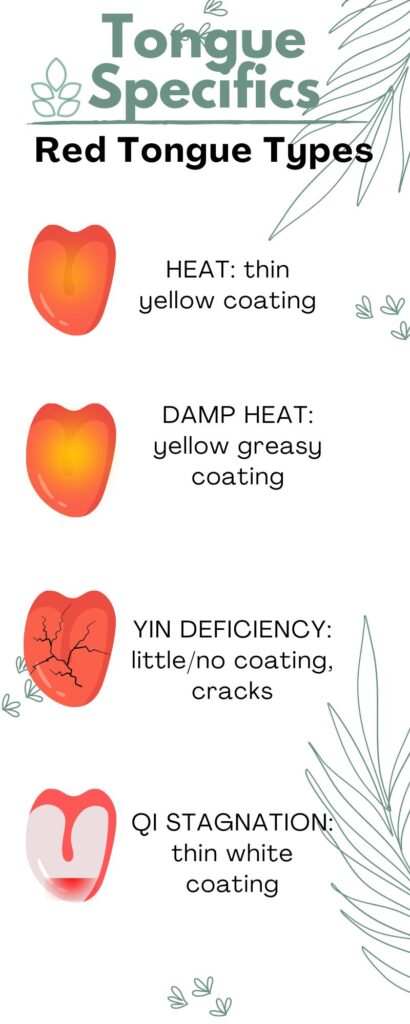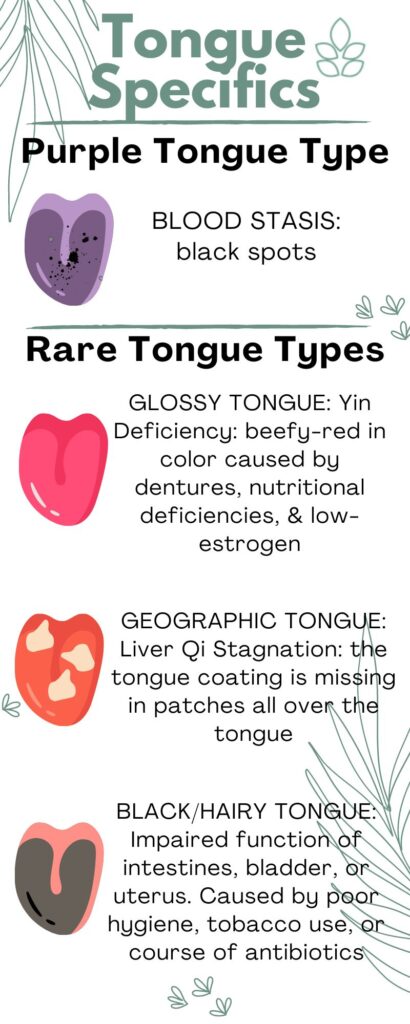Acupuncture providers are trained in Traditional Chinese Medicine tongue diagnosis, and are able to assess the characteristics of the tongue to identify health concerns taking place in the body. The benefit of using tongue diagnosis is that tongue examination is unique to every patient and condition, and can help the provider design an individualized treatment plan. The tongue is our key to understanding what is happening on the inside of the body without actually being able to see the inside of the body in its entirety. Different areas of the tongue reflect the various areas of the body, and give a more detailed clue of the issues plaguing patients.
Fun fact: The tongue is the only muscle in the body not covered by skin, that we can see.
TCM Tongue Diagnosis Mapping Method:
- Zang-Fu:
- The Tongue Tip – reflective of the Heart channel at the very tip, and the top of the tip between the tip and the center, it is reflective for the Lungs.
- The Tongue Center – reflective of the Spleen and Stomach channels.
- The Tongue Base – reflective of the wellness in the Kidney, Bladder, and Intestine channels.
- The Right Side – reflective of the Liver channel.
- The Left Side – reflective of the Gallbladder channel.
- The Tongue Tip – reflective of the Heart channel at the very tip, and the top of the tip between the tip and the center, it is reflective for the Lungs.
- Triple Burner:
- Lower Burner – reflective of the Bladder, Large Intestine, Small Intestine, and Kidney channels located at the base of the tongue.
- Middle Burner – reflective of the Stomach and Spleen channels located in the middle of the tongue.
- Upper Burner – reflective of the Heart and Lung channels located at the tip of the tongue.
- Lower Burner – reflective of the Bladder, Large Intestine, Small Intestine, and Kidney channels located at the base of the tongue.
Analyzing the tongue also breaks down even further as far as the appearance and size indicating the nature, location, and severity of our patient’s condition. Ideally, a patient’s tongue should be pink or light red in color with a thin white coating, although, there are very few people that have a normal tongue by the time they reach their mid-twenties.
Tongue Diagnosis Protocol for Acupuncture Providers
While there is a basic diagram of how the tongue exhibits issues within the body, there are further details that acupuncture providers need to look at to give further clues of a patient’s condition.
Essentially, the acupuncture provider performs a tongue diagnosis to understand information about the health of each organ system.
Tongue Diagnosis Protocol:
- Tongue Color – any other color than light red or pink potentially indicates an imbalance or abnormality in the body. Common tongue colors are as follows:
- Purple Tongue – indicative of blood stasis; presenting with cold limbs, headaches, leg pain, liver spots, chest pain, and lack luster skin.
- Red Tongue – indicative of heat, damp heat, or Yin deficiency, and if just the tip is red, this is indicative of Qi stagnation.
- Heat presenting with sweating easily, excessive thirst, constipation, irritable, and skin problems.
- Damp heat presenting with urinary infections, skin problems, clammy skin, and anger.
- Yin deficiency presenting with night sweats, hot flashes, irritability, insomnia, tinnitus, and menopause.
- Qi stagnation presenting with stress, depression, and unstable emotions.
- Pale Tongue – indicative of Qi deficiency, Yang deficiency, or Blood deficiency, and if just the center is pale, this is indicative of Damp retention.
- Qi deficiency presenting with fatigue, shortness of breath, poor appetite, and anxiety.
- Yang deficiency presenting with pale complexion, back pain, feeling cold, infertility, impotence, and emotional issues.
- Blood deficiency presenting with fatigue, poor memory, palpitations, dizziness, and insomnia.
- Purple Tongue – indicative of blood stasis; presenting with cold limbs, headaches, leg pain, liver spots, chest pain, and lack luster skin.
- Tongue Shape/Size – the shape indicates the body’s deficient or excess condition.
- Thin/Small – dehydration in the body; Qi deficiency, fatigue, dizziness, and anemia.
- Puffy/Swollen – nutritional imbalance in the body; excess of internal dampness, Spleen deficiency, and poor GI health.
- Thin/Small – dehydration in the body; Qi deficiency, fatigue, dizziness, and anemia.
- Tongue Moisture – reveals the state of the fluids in the body.
- Damp – cold issues and damp stagnation
- Dry – imbalance of internal body heat
- Damp – cold issues and damp stagnation




In addition to these characteristics, providers should be looking at tongue veins (blood circulation), tongue coat (GI health), and tongue papule (damp heat in the Liver) as well. This protocol can get even further in depth, looking at the various types of cracks that can often be seen on tongues with each one indicating something different in relation to the condition of the body.
- Cracked Tongue – the amount, length, and depth of the cracks on the tongue will show a deficiency or excess in Blood, Heat, and other fluids throughout the body.
- Center Crack – low stomach fluids and poor digestive system function
- Short Horizontal Cracks – deficiency of Blood or Yin causing stomach dryness
- Crack from Center to Tip – cardiovascular issues
- Long Vertical Center Crack – spine problems
- Center Crack – low stomach fluids and poor digestive system function
It is also vital to mention that any tongue diagnosis should be performed fairly quickly for the most accurate diagnosis as the color of the tongue will change if the tongue is out too long.
According to recent studies, tongue diagnosis has proved to be a helpful depiction of internal issues with patients, as well as be integrated into modern day TCM practices.
Problems and Prospects of Current Studies on the Microecology of Tongue Coating, 2014:
- The goal of this study was to provide an overview of microbiota research of tongue coating and its relationship to TCM in the modern world.
- It concluded that the status of Qi-Blood, Hot or Cold syndrome, and the progress of some diseases “are associated with the change in microbiome on the tongue surface”.
Fun Fact: No two tongues are the same; tongues are as unique as fingerprints.
Intra-Rater and Inter-Rater Reliability of Tongue Coating Diagnosis in Traditional Chinese Medicine Using Smartphones, 2020:
- Being that tongue diagnosis is an important part of TCM, also playing a part in Western medicine, this study aimed to evaluate the reliability of tongue diagnosis on a smartphone.
- The study concluded that the tongue images collected from smartphones do contain reliability in tongue coating, which can be used in mobile health analysis. This study’s findings approved the use of smartphones for telemedicine.
Tongue Diagnosis and Treatment in Traditional Chinese Medicine for Severe COVID-19, 2020:
- Being that COVID-19 swept the nation in 2020 being the cause of a multitude of deaths with severe cases, this particular case study showed the benefit and value from combining Traditional Chinese Medicine and Western medicine. The goal of this study was to find the correlation of tongue diagnosis aspects with the progression of COVID-19.
- The case study found that the fur thickness, fur color, and tongue color closely related to COVID 19 progression by evaluating tongue images on a regular basis. They concluded that based on these findings they can further apply tongue diagnosis with the characteristics of the tongue with someone with COVID 19 to limit the risk. This could potentially be further applied for other conditions.
Deep Learning Based Tongue Prickles Detection in Traditional Chinese Medicine, 2022:
- The goal of this study was to solve the issue of prickle recognition being subjective and susceptible to external factors. Researchers of this study propose an “end to end prickle detection workflow based on deep learning”.
- This study concluded after the training on the data that this type of workflow provides the overall number of symptoms and disease diagnosis based on tongue characteristics. Additionally, it was also found to be convenient for transferring this model to find petechiae on tongue images.
